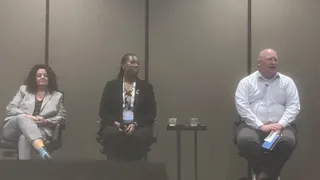
VCIA panel urges early action to combat rising nuclear verdicts
Nuclear verdicts—jury awards so disproportionate to economic damages that they threaten an organisation’s stability—are a growing challenge for the insurance industry, including captives.
That was the sentiment of a panel of experts assembled at the Vermont Captive Insurance Association conference, taking place in Burlington, Vermont, this week.
A panel on “Proactively Fighting Social Inflation and Devastating Verdicts” was moderated by Derek Freihaut principal & consulting actuary at Pinnacle Actuarial Resources. It comprised panellists Melissa Hollingsworth, deputy chief risk officer of the Los Angeles Unified School District and Denise Tyson, chief executive of Schaefer City Technologies. The session explored definitions, causes, impacts, and proactive countermeasures.
The panel opened by framing nuclear verdicts as not merely those over $10 million, but any verdict where non-economic damages vastly exceed economic losses.
Tyson explained: “You’ve got $100,000 of economics … and you get hit for a million dollars. That’s nuclear.”
Hollingsworth stressed that many losses escalate because early red flags go unaddressed. In her claims work, she tracked loss runs weekly to spot developing risks, warning that under-reserving can leave organisations blindsided by multi-million-dollar demands. Communication across departments, actuaries, brokers, and underwriters, she said, is “critical … so I don’t want anyone to be surprised.”
Tyson traced the term “social inflation” back to Warren Buffett in the 1970s, noting that litigation strategies have shifted from sympathy to anger, fuelled by AI, aggressive damages anchoring, and third-party litigation funding. These trends, combined with courts’ post-pandemic backlog, have driven both the frequency and severity of nuclear verdicts upward. In just the first seven months of 2025, there were 70 verdicts exceeding $10 million, averaging $238 million across 20 states.
Freihaut outlined the actuarial implications: inadequate reserves, increased volatility, and tougher excess insurance renewals. Hollingsworth warned that repeated large verdicts can lead markets to “turn tail and run,” leaving entities labelled uninsurable.
The panel agreed that prevention must start before trial. Tyson urged embracing available technologies: “Plaintiff attorneys are using them. We have to use them.” Predictive analytics and AI can score claims red-yellow-green, flagging high-risk files for early settlement or aggressive defence. One RRG client, she said, halved a policy-limit demand by acting early on a “red” claim.
Hollingsworth encouraged an open mind: “Control what you can and use tools to help you build the best programme possible.” She emphasised that AI complements, not replaces, human judgment—claims professionals must still interpret data, account for nuances, and adapt strategies dynamically.
Ethical considerations, particularly bias in AI models, were addressed candidly. Tyson noted that patterns in historical data (e.g., women receiving higher awards) can shape outputs. While bias can’t be eliminated, it can be mitigated through careful programming and prompt design. Hollingsworth reminded the audience that humans remain essential to validate and apply insights effectively.
On regulatory perceptions, Tyson acknowledged that social inflation’s reality is sometimes dismissed by regulators as an “excuse” for rising rates, despite its demonstrable impact.
In closing, the panel reinforced that fighting nuclear verdicts requires vigilance from the very beginning of a claim or potential dispute onwards, robust reserving, full-spectrum communication, adoption of advanced analytical tools, and strategic claims handling. As Hollingsworth put it, “There’s always room for improvement, and we have some fantastic tools to help us get there.”
Celebrate 40 Years of VCIA!
As the captive community gathers in Burlington for the VCIA Annual Conference, explore our special 40th Anniversary Edition. Packed with exclusive interviews, regulator insights, and reflections from industry leaders, it’s a tribute to four decades of innovation, connection, and leadership in Vermont’s captive market.
Read this Special Edition now.
Did you get value from this story? Sign up to our free daily newsletters and get stories like this sent straight to your inbox.

